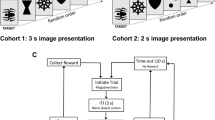Abstract
Psychomotor stimulant drugs such as caffeine, nicotine, amphetamine and cocaine, have been shown to improve vigilance in man under conditions of fatigue. Nicotine has also been shown to improve performance in some cognitive tests in patients with Alzheimer's disease. In rodents these drugs increase activity which may confound “performance enhancing effects” in rodent models. However, improvements have been found in a number of tests that do not seem to be directly dependent upon an enhancement of locomotor activation. In one example, Evenden and Robbins (1985) reported consistent improvements in a visual tracking test following amphetamine. The present study was undertaken to determine whether these performance enhancing effects of amphetamine could also be obtained with cocaine and apomorphine, which both have psychomotor stimulant effects through their actions as, respectively, indirect and direct dopamine agonists, and by caffeine and nicotine, which do not have a direct dopaminergic mechanism of action. The results of the study indicate that all five drugs improved tracking performance at one or more doses. The most consistent effects were obtained with amphetamine which, like cocaine and nicotine, improved tracking at a dose which did not produce other changes in behaviour. Taking into account previous studies (Evenden and Robbins 1983, 1985), these results were interpreted as indicating that psychomotor stimulant drugs produce ageneral activation of behaviour. At all but the highest doses of such drugs, the form of behaviour that is observed depends upon the environment. The results of this study support the conclusion that in the situation where stimuli are present which exert a strong control over behaviour in the undrugged state, then the stimulated behaviour will be directed towards those, and may result in an enhancement of performance.
Similar content being viewed by others
References
Altman HJ, Normile HJ, Gershon S (1987) Non-cholinergic pharmacology in human cognitive disorders. In: Stahl SM, Iversen SD, Goodman EC (eds) Cognitive neurochemistry. Oxford University Press, Oxford, pp 346–371
Calhoun WH, Jones EA (1974) Methamphetamine's effects on repeated acquisitions with serial discrimination reversals. Psychopharmacologia 39:303–308
Clarke PBS, Fu DS, Jakubovic A, Fibiger HC (1988) Evidence that mesolimbic dopaminergic activation underlies the locomotor stimulant action of nicotine in rats. J Pharmacol Exp Ther 246:701–708
Doty RL, Ferguson-Segall M (1987) Odor detection performance of rats followingd-amphetamine treatment: a signal detection analysis. Psychopharmacology 93:87–93
Dunne MP, Hartley LR (1986) Scopolamine and the control of attention in humans. Psychopharmacology 89:94–97
Evenden JL (1988) Effects of scopolamine on visual tracking in the rat: similarities between systemic administration and infusions into lateral prefrontal cortex. Psychopharmacology 96:S18
Evenden JL, Doggett SJ (1989) A comparison of the effects of amphetamine, apomorphine and white noise on response switching in the rat. Psychopharmacology 97:238–242
Evenden JL, Robbins TW (1983) Increased response switching, perseveration and perseverative switching followingd-amphetamine in the rat. Psychopharmacology 80:67–73
Evenden JL, Robbins TW (1985) The effects of d-amphetamine, chlordiazepoxide and alpha-flupenthixol on food-reinforced tracking of a visual stimulus by rats. Psychopharmacology 85:361–366
Evenden JL, Ryan CN (1988) Order and disorder of behaviour: the dopamine connection. In: Simon P, Soubrié P, Widlocher D (eds) An inquiry into schizophrenia and depression. Karger, Basle, pp 49–88
Goldstein A, Kaizer S, Warren R (1965) Psychotropic effects of caffeine in man. II. Alertness, psychomotor coordination and mood. J Pharmacol Exp Ther 150:146–151
Joyce EM, Koob GF (1981) Amphetamine-, scopolamine- and caffeine-induced locomotor activity following 6-hydroxydopamine lesions of the mesolimbic dopamine system. Psychopharmacology 73:311–313
Kellehen RT (1977) Psychomotor stimulants. In: Pradhan SN, Dutta SN (eds) Drug abuse; the clinical and basic aspects. CV Mosby, St. Louis, pp 116–147
Laties VG, Weiss B (1966) Performance enhancement by the amphetamines: a new appraisal. Excerpta Medica International Congress Series, 129:800–808
Newhouse PA, Sunderland T, Tariot PN, Blumhardt CL, Weingartner H, Mellow A, Murphy DL (1988) Intravenous nicotine in Alzheimer's disease: a pilot study. Psychopharmacology 95:171–175
Perry EK, Tomlinson BE, Blessed G, Bergmann K, Gibson PH, Perry RH (1978) Correlation of cholinergic abnormalities with senile plaques and mental test scores in senile dementia. BMJ ii:1457–1459
Poncelet M, Chermat R, Soubrie P, Simon P (1983) The progressive ratio schedule as a model for studying the psychomotor stimulant activity of drugs in the rat. Psychopharmacology 80:184–189
Rech RH (1966) Amphetamine effects on poor performance of rats in a shuttle box. Psychopharmacologia 9:110–117
Robbins TW (1978) The acquisition of responding with conditioned reinforcement: effects of pipradrol, methylphenidate,d-amphetamine, and nomifensine. Psychopharmacology 58:79–87
Robbins TW, Watson BA, Gaskin M, Ennis C (1983) Contrasting interactions of pipradrol, d-amphetamine, cocaine, cocaine analogues, apomorphine and other drugs with conditioned reinforcement. Psychopharmacology 80:113–119
Rylander G (1969) Clinical and medico-criminological aspects of addictions to central stimulating drugs. In: Sjoquist F, Tottie M (eds) Abuse of central stimulants. Raven Press, New York, pp 251–273
Sahakian BJ, Jones G, Levy R, Gray J, Warburton D (1989) The effects of nicotine on attention, information processing, and short-term memory in patients with dementia of the Alzheimer type. Br J Psychiatry 154:797–800
Taylor JR, Robbins TW (1984) Enhanced behavioural control by conditioned reinforcers following microinjections ofd-amphetamine into the nucleus accumbens. Psychopharmacology 84:405–412
Taylor JR, Robbins TW (1986) 6-Hydroxydopamine lesions of the nucleus accumbens, but not of the caudate nucleus, attenuate enhanced responding with reward-related stimuli produced by intra-accumbensd-amphetamine. Psychopharmacology 90:390–397
Warburton DM (1987) Drugs and the processing of information. In: Stahl SM, Iversen SD, Goodman EC (eds) Cognitive neurochemistry. Oxford University Press, Oxford, pp 111–134
Weiss B, Laties VG (1962) Enhancement of human performance by caffeine and the amphetamines. Pharmacol Rev 14:1–36
Wesnes K, Warburton DM (1983) Smoking, nicotine and human performance. Pharmacol Ther 21:189–208
Wesnes K, Warburton DM (1984) Effects of scopolamine and nicotine on human rapid information processing performance. Psychopharmacology 82:147–150
Author information
Authors and Affiliations
Rights and permissions
About this article
Cite this article
Evenden, J.L., Turpin, M., Oliver, L. et al. Caffeine and nicotine improve visual tracking by rats: a comparison with amphetamine, cocaine and apomorphine. Psychopharmacology 110, 169–176 (1993). https://doi.org/10.1007/BF02246968
Received:
Revised:
Issue Date:
DOI: https://doi.org/10.1007/BF02246968




